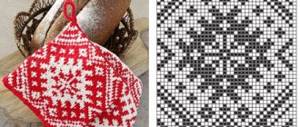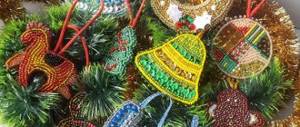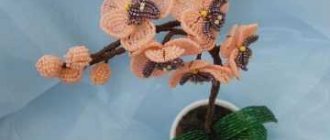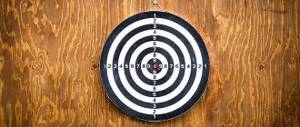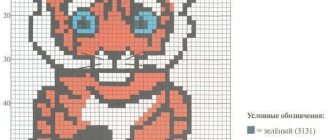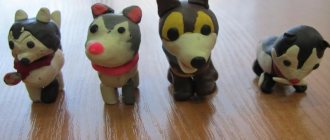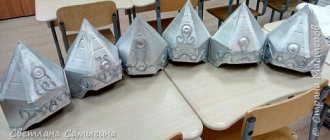Before you start working on slippers, select the material and tools.
Yarn. What do you need to know?
Varieties of yarn
Natural
- cotton
Pros: yarn, easy to work with; wide range of colors
Cons: long drying time after washing; If the washing temperature is incorrect, the product may “shrink”
- linen
Pros: yarn, easy to work with; quick drying after washing
Cons: the color range is limited to natural shades; If the washing temperature is incorrect, the product may “shrink”
- wool
Pros: the yarn is warm; large selection of colors and types
Disadvantages: the yarn is very finicky in subsequent care; if the washing temperature is incorrect, the product may “shrink”; if dried/ironed incorrectly, it may stretch; often irritates the skin and can cause allergic reactions (especially in children); wears out quickly with active wear
Everything you need for knitting
Mixed
Combines the best properties of natural and artificial materials
Artificial
- polyesteracrylic
Pros: good selection of colors;
the yarn is easy to work with;
good heat capacity (especially acrylic)
Cons: yarn can become electrified; characterized by poor hygroscopicity; during wear, so-called “coils” may appear on the product; some note the characteristic “creaking” of the yarn
Knitting needles and crochet hook. How to choose the tool number?
For threads less than 4 mm thick, the needle thickness should be 1 mm larger. For example, the thickness of the yarn in the figure is 1 mm, the knitting needles are 2 mm. For a thread with a thickness of more than 4 mm, the thickness of the knitting needles should be 1.5-2 mm larger. For 3mm thick yarn, the best working needles are 6mm needles.
How to choose knitting needles and yarn
If you are going to knit a voluminous pattern with braids (plaits), the size of the knitting needles should be another 0.5 mm larger
An openwork pattern or a pattern with dropped loops requires knitting needles 0.5 mm smaller than expected based on the thickness of the yarn
A small reminder on choosing the thickness of yarn and knitting needles is presented in the infographic below
The hook is selected by analogy with knitting needles
Important: the tool number corresponds to its thickness. For example, No. 2.5 means that the thickness of the knitting needles/hook is 2.5 mm
Basic knitting techniques for knitting needles
- The simplest set of knitting stitches
Advice. If you are working with thin yarn, it is better to make a cast on 2 knitting needles, so the edge will be more elastic
To calculate the length of the free end of the thread for a set of loops in centimeters, multiply the number of loops in the description by 2
Make a loop in any way convenient for you and put it on knitting needles folded together. Tighten the loop a little
Thread the threads around the thumb and index fingers of your left hand. The free end of the thread should be on the thumb, the thread from the ball should be on the index finger. Secure the threads by pressing them against your palm with your free fingers.
Hold the loop on the knitting needles with the index finger of your right hand
Hook the thread lying around your thumb with the knitting needle (movement 1 with the red dotted line in the diagram) Guide the knitting needle with the hooked thread on the left side of the index finger (movement 2 with the dotted line in the diagram)
Make a knitting movement from top to bottom → from right to left → under the thread on the left of your thumb. Then slip the yarn off your thumb, forming a loop on the needle (movement 3 with the dotted line in the diagram). Cast on the required number of stitches
How to knit a knit stitch
How to knit a purl loop
How to knit a yarn over
How to knit two stitches together with a knit stitch slanted to the right
How to knit two stitches together with a knit stitch slanting to the left
How to close loops
Basic crochet techniques
The first loop of the air chain
First loop and air chain
Single crochet, half double crochet, double crochet
Elastic band made of posts, ring, connecting post
The basics are covered, let's start knitting
Beautiful knitted slippers, description
Trendy patchwork style slippers will definitely please and warm the people you love. The knitting technique is very simple and even beginner knitters can do it.
In addition, the pattern “Squares knitted diagonally” is suitable not only for knitting slippers, but also for making blankets or decorative pillows
Patchwork pillow and slippers
A short introduction before work
Determine your foot length. The photo below will tell you how to do this correctly.
Correspondence of foot length to the size of insoles and shoes for adults
The diagonal of the base square should be equal to ½ the length of the foot. For example, for a foot with shoe size 37 and a foot length of 22.6-23.3 cm, you will need a square with a diagonal of 11.3-11.7 cm and a side of 8-8.5 cm
Advice. Before you start working directly on the slippers, knit a test square from the selected yarn and calculate the loops taking into account the performance characteristics of the yarn, the knitting needles you have chosen, and your knitting style
The description below assumes the finished product will fit a women's average size (37-38 or M)
Required materials and tools:
- yarn of your choice (for women's and men's slippers - 300-400 g, for children's slippers - 150-200 g)
- knitting needles 2.25 (correspond to yarn characteristics)
Basic knitting: garter stitch
Knit and purl rows are knitted with knit stitches
Knitting density: 46 loops = 10 cm
How to knit square 1 and square 2. Design of the toe/toe of the product
Cast on 37 stitches on the knitting needles
1st row and all odd ones: knit stitches 2nd row: 1 edge stitch, 16 knit stitches, 3 knit stitches together (slip 1st of three loops without knitting, knit 2nd and 3rd stitches together, put on removed loop on a knitted one), 16 knit, 1 edge. After knitting a row, there are 35 stitches left on the knitting needle. 3rd row: 1 edge stitch, 15 knit stitches, 3 knit stitches together, 15 knit stitches, 1 edge loop. After knitting a row on a knitting needle - 33 loops 5th row: 1 edge, 14 knit, 3 loops together with knit, 14 knit, 1 edge. After knitting a row on a knitting needle - 31 loops. Knit, decreasing three loops in each even row until 9 loops remain on the knitting needles.
Take a control measurement of the connected element and make sure that the diagonal of the square is equal to ½ the length of the foot of the future owner of the slippers
You have 9 loops of square 1 left on your knitting needle. They will become the basis for square 2
1st row: 9 square stitches 1, knit, add 14 stitches along the edge row of the left side of the square. On the knitting needle: 23 loops Row 2: knit 14 stitches and extend the row with 14 loops along the other edge of the square. You have 37 loops on your knitting needle
Knit by analogy with square 1
All odd rows: knit All even: knit 3 central loops together. When the last loop is closed, you will get a kind of “boat” that will form the toe of the future sneaker
How to knit square 3 and square 4. Design of the side parts of the product
Cast on 37 knit stitches along the edge row of one side of the sock Continue knitting according to the pattern All odd rows: knit All even rows: knit 3 central loops together
When square 3 is completed, knit symmetrical square 4
How to knit square 5 and square 6. Heel design
Continue working according to the established scheme
Cast on 37 knit stitches along the edges of the squares (3 and 4) All odd rows: knit stitches All even rows: knit 3 central loops together Continue knitting until there are 9 loops left on the knitting needle By analogy with the design of the toe of the product, make the last square of the heel
All that remains is to create an armhole for the ankle and the slippers are ready. The knitting algorithm for the second slipper is similar to the first
The armhole is made in any way convenient for you using stocking hooks
https://youtu.be/https://youtu.be/LkCmOQ2v7TI
_
Features of knitted slippers
Knitting slippers yourself is not difficult, but if you get used to it, you can do it in one evening. Most often, knitting is based on simple patterns made using basic knit and purl stitches.
Yarn selection
To create fashionable slippers, both plain and colored yarn is suitable; you can also use leftovers of various colors. For the cold season, choose dense wool blend or wool yarn twisted from several threads. For hot weather, it is better to choose natural threads - cotton or linen.
Interesting: Sports fashion 2020
Sole
The sole is the most vulnerable place. It first of all becomes unusable, so when making the sole you can:
- add a dense nylon thread to regular yarn;
- make a two-layer base;
- attach a special purchase;
- sew an insole made of leather or suede;
- use threads that have undergone special treatment and are less susceptible to abrasion.
Spokes
The selection of tools depends on each specific model of slippers. Some are performed using two regular needles, while others will require at least five special needles. The sole is often created using a hook.
Knitted slippers for beginners
If the previous slippers seemed too complicated due to the elements that are tied to each other, try knitting the model below
All you need to do is knit 8 squares with a side of 9 cm and a diagonal of 12.7 (foot length 25 cm, size 39-40)
Basic knitting: garter stitch
Once all the squares are ready, arrange them according to the diagram and sew them together
Wonderful and cozy house shoes are ready
Men's knitted slippers, diagram
This model is distinguished by its ease of execution, since there is no “toe” decrease in stitches typical for slippers, which scares off inexperienced knitters.
These slippers will warm both men's feet and little children's feet.
Materials and tools:
Thick yarn with density (110 m/50 g) - 200 g
Knitting needles (according to yarn) - #4.5
Main knitting: knit stitch (odd rows are knitted with knit stitches, even rows are knitted with purl stitches) Additional knitting: garter stitch (all rows are knitted with knit stitches) Knitting density: 16 loops = 10 cm Algorithm for knitting slippers, size 43 (27 cm along the length of the foot)
Upper cuff
Cast on 55 stitches on the knitting needles
Knit the first nine rows in garter stitch. Row 10: purl all stitches.
middle part
Select the central knitting loop (28th in a row). The loop can be highlighted with a pin, a special marker ring, or a bright thread. Row 11: edge loop, 26 knit stitches, yarn over, central loop knitted over, yarn over, 26 knit stitches, edge loop. On the knitting needle - 57 loops 12th row and all subsequent even rows up to the 38th row: purl loops 13th and all subsequent odd rows up to the 37th row: edge loop, section of knit stitches, yarn over, central loop is knitted, yarn over, section of knit stitches, edge loop 37th row: edge loop, 40 knit loops, yarn over, central knit loop, yarn over, 40 knit loops, edge loop. On knitting needles - 85 loops
Bottom edge
39th row: all knit (edge, 83 loops, edge) 40th row: all knit 41st row: all knit 42nd row: all knit
Sole
43rd row: edge loop, 2 knit loops together with a slant to the left, 37 knit loops, 2 loops together with a slant to the right, central knit, 2 loops together with a slant to the right, 37 knit loops, 2 loops together with a slant to the left, edge loop. On the knitting needles - 81 loops 44th row and all even rows: purl loops 45th row: edge loop, 2 knit loops together with a slant to the left, 35 knit loops, 2 loops together with a slant to the right, central knit, 2 loops together with a slant to the right, 35 knit stitches, 2 loops along with a left slant, edge loop. On knitting needles - 77 loops 47th row: edge, 2 knit loops together with a slant to the left, 33 knit loops, 2 loops together with a slant to the right, central knit, 2 loops together with a slant to the right, 33 knit loops, 2 loops together with a slant to the left, edge loop. There are 73 stitches on the knitting needles. Cast off the stitches.
Finished slippers before assembly
The second half pair is knitted similarly. Sew along the edge and sole.
Women's knitted slippers, diagram
Delicate and very elegant slippers, similar to elegant ballet shoes
Materials and tools:
Yarn - 100-150 g
Knitting needles (according to yarn) - #2.5
Main knitting: knit stitch (odd rows are knitted with knit stitches, even rows are knitted with knit stitches) Additional knitting: garter stitch (all rows are knitted with knit stitches)
Knitting density: 20 loops = 10 cm
Algorithm for knitting slippers, size 37 (23 cm along the length of the foot)
Cast on 35 stitches on the knitting needles, continue working, focusing on the diagram
1st row: edge loop, 33 knit stitches, edge loop
2nd row: edge loop, 32 knit loops, add one loop from the broach, 1 knit stitch, edge 3rd and all subsequent rows up to the 17th: knit loops 4th row: edge loop, 33 knit loops, add one loop from broach, 1 front, edge. There are 37 loops on the knitting needle. 6th row: knit by analogy with the 4th.
Repeat adding stitches until there are 44 stitches on the needles.
Cast off 20 stitches on straight side B (see diagram), knit the remaining stitches in stockinette stitch (1 row)
On side B, cast on 20 stitches again. Knit 18 rows in garter stitch, removing 1 stitch from side A at the beginning of each knit stitch (knit 2 stitches 1). Repeat decrease 9 times
From side B, cast off 8 loops. Proceed to design the sole of the half-pair (you can use a thread of a darker color)
The sole is knitted in garter stitch. In each even row, increase 1 knit stitch on both sides of the row. Repeat the addition 8 times. The number of loops will increase by 16.
Then decrease each even row by 1 stitch on each side of the row. Repeat decreasing 8 times until you return to the original number of stitches.
Close the loops. Sew the seams.
How to knit a rose: Cast on 50 stitches.
Knit 6 rows in stockinette stitch
Close the loops
Twist the knitted ribbon in the shape of a flower, secure with threads
Sew a rosette to a slipper
You can decorate your slippers with decorative bows, buttons, sequins, etc.
The second half pair is knitted in mirror symmetry
From several squares
Making such slippers is very simple, even a beginner will not need much time. They are also made on two knitting needles, and at the end they are crocheted. At the end of the work, the parts are sewn together according to the diagram below. The result will be slippers designed for foot sizes 36-39. Below is a detailed description of how to knit slippers with knitting needles.
Before you start, you need to stock up on:
- dense acrylic yarn with 30% wool content;
- knitting needles number 4, crochet.
The main parts are knitted using the “Rice” and “Grain” (“Pearl”) pattern. If you want to get striped slippers, alternate knitting first two rows of one color, then another. Pattern density: a 10 by 10 cm square equals 15 loops per 15 rows.
The “Rice” pattern is knitted as follows:
- Row 1 – 1 edge, 1 knit, 1 purl, 1 knit, 1 purl, etc.
- 2nd and 4th rows - according to the picture;
- Row 3 – 1 edge, 1 purl, 1 knit, 1 purl, 1 knit, etc.
The “Grain” (“Pearl”) pattern consists of a simple alternation of front and back loops.
So, let's start knitting.
- We cast on 15 loops and knit 10 cm. In this way we make two squares with the “Grain” pattern. This is workpiece A. Then we thread the thread through the loops and do not close them. This will give us a more flexible seam.
- To obtain workpiece B, you need to cast on 15 loops again and knit 10 cm with the “Rice” pattern. We also thread the thread and do not close the loops.
- Workpiece C is obtained by knitting one square with the “Rice” pattern. We also knit a sample 10 cm long, do not close the loops and thread the thread.
- We make two D squares, also casting on 15 stitches and knitting 10 cm. We use garter stitch. We make product E in the same way.
Interesting: Effective face masks for acne and blackheads
Now let's assemble the product.
Look at the diagram and connect all the parts. To complete the slipper, sew the top together by connecting the sides of elements C and D. Once the product is finished, crochet the sides of the squares E using a crochet hook.
The second slipper is created by analogy with the first.
https://youtu.be/https://youtu.be/ACq1ZgbEbak
_
Children's knitted slippers, diagram
By analogy with the previous pattern, you can knit wonderful children's slippers
And another great idea for simple children's slippers, knitted with your own hands
To make such slippers you will need two rectangles:
one for the sole. Accordingly, the width of this element is equal to the width of the foot, and the length is equal to the length of the foot. Don't forget about the seam allowances! The second one is the top of the sneaker. The width should match the width of the rectangle-sole, the length should be 2 times the length of the first part
Sew the blank rectangles according to the pattern and decorate as you wish
Important: slippers are sewn in a mirror image!
Knitted slippers with felt soles, diagram
The proposed option will not require much time and effort, but will provide warmth and comfort.
All you need:
- felt sole
- yarn
- knitting needles and needle and threads for stitching
Knit a long piece of fabric into a scarf. The length and width of the fabric depend on the size of the insole
When the fabric is ready, sew it to the insole, following the diagram for children's slippers presented above and the photo below
From a rectangle
To make such a stylish and attractive model of slippers, you will need to knit a regular rectangle, and then sew the product along the sole. We offer step-by-step instructions on how to knit square slippers for beginners using just two knitting needles.
These products are very easy to make; no patterns are required. To create a slipper you will only need one piece.
First, let's calculate the length and width of the rectangle that is needed to create slippers of the desired size. The size of the final product is determined by the length of the seam on the heel; in this master class it measures 35 by 10 cm (size 36-38).
As for yarn, in this case it is better to choose threads with the maximum percentage of wool content, so the product will be more elastic. When creating our square for slippers, you will need garter stitch - all stitches are knitted.
Please note that garter stitch stretches in width, while there is practically no deformation in height.
Knitted slippers-socks, diagram
Sock slippers, known as Japanese knitted slippers, are very comfortable and, like everything Japanese, extremely easy to make.

